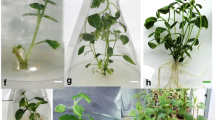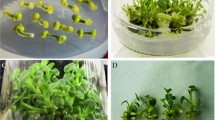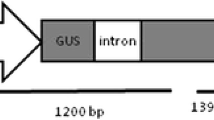Abstract
A root-derived callus line of Panax sikkimensis that stably accumulates anthocyanins was established by small cell aggregate selection method. The selected line showed a growth index of 221.36 and an anthocyanin content of 2.76 mg/g fw (7.076% dw) in 50–60 d of growth on a modified MS medium containing 4.5 µM 2,4-dichlorophenoxy acetic acid and 1.2 µM kinetin under 16-h light and 8-h dark photoperiodic conditions. Incubation under continuous light increased the growth index to 435.57 but led to a marginal dilution of anthocyanin content to 2.192 mg/g fw (6.928% dw). The purple-red pigment had absorption maximum at 528 nm. The selected callus line has shown sustained growth and productivity for more than 6 yr now. Interestingly, pigment accumulation in the selected line did not hinder the ginsenoside production in the callus tissue (0.9–1.2% fw).


Similar content being viewed by others
References
Bennet S. S. R.; Sharma B. K. Indian ginsengs. Indian For 109: 840–847; 1983.
Cállebáut A.; Hendrickx G.; Voets A. M.; Motte J. C. Anthocyanin in cell cultures of Ajuga reptans. Phytochemistry 29: 2153–2158; 1990.
Choi K. T. Panax ginseng C.A.Meyer. Micropropagation and the in vitro production of saponins. In: Bajaj Y. P. S. (ed) Biotechnology in agriculture and forestry, medicinal and aromatic plants I. Springer, Berlin, pp 484–500; 1988.
Cormier F.; Crevier H. A.; Do C. B. Effects of sucrose concentration on the accumulation of anthocyanins in grape (Vitis vinifera) cell suspension. Can J Bot 68: 1822–1825; 1990.
Cormier F.; Do C. B. Vitis vinifera L. In vitro production of anthocyanins. In: Bajaj Y. P. S. (ed) Biotechnology in agriculture and forestry, medicinal and aromatic plants V, vol. 24. Springer, Berlin, pp 373–386; 1993.
Grusak M. A.; Rogers R. B.; Yousef G. G.; Erdman J. W.; Jr L. M. A. An enclosed chamber labeling system for the safe 14C-enrichment of phytochemicals in plant cell suspension cultures. In Vitro Cell Dev Biol Plant 40: 80–85; 2004.
Haughton P. Roots of remedies: plants, people and pharmaceuticals. Chem Ind 1: 15–19; 1999.
Hirner A.; Veit S.; Seitz H. Regulation of anthocyanin biosynthesis in UV-A irradiated cell cultures of carrot and in organs of intact carrot plants. Plant Sci 161: 315–322; 2001.
Kandil F. E.; Song L.; Pezzuto J. M.; Marley K.; Seigler D. S.; Smith M. A. L. Isolation of oligomeric proanthocyanidins from flavonoid-producing cell cultures. In Vitro Cell Dev Biol Plant 36: 492–500; 2000.
Kang S.; Seeram N.; Nair M.; Bourquin L. Tart cherry anthocyanins inhibit tumor development in Apc (Min) mice and reduce proliferation of human colon cancer cells. Cancer Lett 194: 13–19; 2003.
Kobayashi Y.; Akita M.; Sakamoto K.; Liu H.; Shigeoka T.; Koyano T.; Kamamura M.; Furuya T. Large scale production of anthocyanin by Aralia cordata cell suspension cultures. Appl Microbiol Biotechnol 40: 215–218; 1993.
Konczak-Islam I.; Yoshinaga M.; Hou M.; Terahara N.; Yamakawa O. Potential chemopreventive properties of anthocyanin rich aqueous extracts from in vitro produced tissue of sweet potato (Ipomoea batatus L.). J Agr Food Chem 51: 5916–5922; 2003.
Konczak-Islam I.; Yoshinaga M.; Nakatani N.; Terahara N.; Yamakawa O. Establishment of an anthocyanin-producing cell line from sweet potato storage root. Plant Cell Rep 9: 472–477; 2000.
Lila M. A. Anthocyanins and human health: an in vitro investigative approach. J Biomed Biotechnol 5: 306–313; 2004.
Liu R. Health benefits of fruit and vegetables are from additive and synergistic combinations of phytochemicals. Amer J Clin Nutr 78: 517S–520S; 2003.
Mathur A.; Ahuja P. S.; Mathur A. K. Micropropagation of P. quinquefolium, Rauvolfia serpentina and some other medicinal and aromatic plants of India. In: Quynh N. T.; Uyen N. V. (eds) Proc. SE Asian Regional Workshop on Propagation Techniques for Commercial Crops of Tropics. Vietnam, pp 155–173; 1993.
Mathur A.; Mathur A. K.; Pal M.; Uniyal G. C. Comparison of qualitative and quantitative in vitro ginsenoside production in callus cultures of three species of Panax. Planta Med 5: 484–486; 1999.
Mathur A.; Mathur A. K.; Sangwan R. S.; Gangwar A.; Uniyal G. C. Differential responses, ginsenoside metabolism and RAPD pattern of three Panax species. Genet Res Crop Evolution 50: 245–252; 2003.
Mathur A.; Shukla Y. N.; Pal M.; Ahuja P. S.; Uniyal G. C. Saponin production in callus and cell suspension cultures of Panax quinquefolium. Phytochemistry 35: 1221–1225; 1994.
Mehta K.; Haridasan K. The ginsengs in Arunachal Pradesh. Arunachal For News 10: 56–58; 1992.
Meyer H. J.; van Staden J. The in vitro production of an anthocyanin from callus cultures of Oxalis linearis. Plant Cell Tiss Org Cult 40: 55–58; 1995.
Mori T.; Sakurai M.; Sakuta M. Effects of conditioned medium on activities of PAL, CHS, DAHP synthase (DS-Co and DS-Mn) and anthocyanin production in suspension cultures of Fragaria ananassa. Plant Sci 160: 335–360; 2001.
Murashige T.; Skoog F. A revised medium for rapid growth and bioassays with tobacco tissue cultures. Physiol Plant 15: 473–497; 1962.
Ngan F.; Shaw P.; But P.; Wang J. Molecular authentication of Panax species. Phytochemistry 50: 787–791; 1999.
Nocerino E.; Amato M.; Izzo A. A. The aphrodisiac and adaptogenic properties of ginseng. Fitoterapia 71: S1–S5; 2000.
Payne G.; Bringi V.; Prince C.; Shuler M. Plant cell and tissue cultures in liquid systems. Hanser, New York; 1992.
Sakamoto K.; Iida K.; Koyano T.; Asada Y.; Furuya T. Method for selecting anthocyanin producing cells by a cell sorter. Planta Med 60: 253–259; 1994.
Seitz H. U.; Hinderer W. Anthocyanins. In: Constabel F.; Vasil I. K. (eds) Cell culture and somatic cell genetics of plants, phytochemicals in plant cell cultures, vol. 5. Academic, New York, pp 49–76; 1988.
Shukla Y. N.; Thakur R. S. Saponins of Panax pseudo-ginseng subsp. himalaicus var. angustifolius rhizomes. Planta Med 54: 367–368; 1988.
Shuler M.; Hirasuna T.; Prince C.; Bringi V. Bioreactor considerations for producing flavours and pigments from plant tissue culture. In: Schwarzberg H.; Rao M. (eds) Bioprocess and food process engineering. Marcel Decker, New York, pp 45–66; 1990.
Suzuki M. Enhancement of anthocyanin accumulation by high osmotic stress and low pH in grape cells (Vitis hybrids). J Plant Physiol 147: 152–155; 1995.
Verpoorte R.; Alfermann A. W. Metabolic engineering of plant secondary metabolism. Kluwer Academic, Dordrecht; 2000.
Vitrac X.; Larronde F.; Krisa F.; Decendit A.; Deffieux G.; Merillon J. M. Sugar sensing and Ca+2 -calmodulin requirement in Vitis vinifera cells producing anthocyanins. Phytochemistry 53: 659–665; 2000.
Yamakawa T.; Kato S.; Ishida K.; Kodama T.; Minoda T. Production of anthocyanin by Vitis cells in suspension culture. Agr Biol Chem 47: 2185–2191; 1983.
Yousef G.; Seiger D. S.; Grusak M. A.; Rogers R. B.; Knight C. T. G.; Kraft T. F. B.; Erdman Jr. J. W.; Lila M. A. Biosynthesis and characterisation of 14C enriched flavonoid fractions from plant cell suspension cultures. J Agr Food Chem 52: 1138–1145; 2004.
Zhong J.; Yoshida M.; Fujiyama D.; Seki T.; Yoshida T. Enhancement of anthocyanin production by Perilla frutescens cells in a stirred bioreactor with internal light irradiation. J Ferment Bioeng 75: 299–303; 1993.
Zubko M.; Schmeer K.; Glabgen W.; Bayer E.; Seitz H. Selection of anthocyanin accumulating potato (Solanum tuberosum L.) cell lines from calli derived from seedlings germinated from gamma-irradiated seeds. Plant Cell Rep 12: 555–558; 1993.
Acknowledgments
The authors wish to thank the Council of Scientific and Industrial Research (CSIR), New Delhi and Director CIMAP for the financial support and facilities for this work. AM also thanks the International Foundation for Science (IFS), Sweden for the partial funding to this investigation.
Author information
Authors and Affiliations
Corresponding author
Additional information
Editor: D. T. Tomes
Rights and permissions
About this article
Cite this article
Mathur, A., Mathur, A.K., Gangwar, A. et al. Anthocyanin production in a callus line of Panax sikkimensis Ban. In Vitro Cell.Dev.Biol.-Plant 46, 13–21 (2010). https://doi.org/10.1007/s11627-009-9253-3
Received:
Accepted:
Published:
Issue Date:
DOI: https://doi.org/10.1007/s11627-009-9253-3




